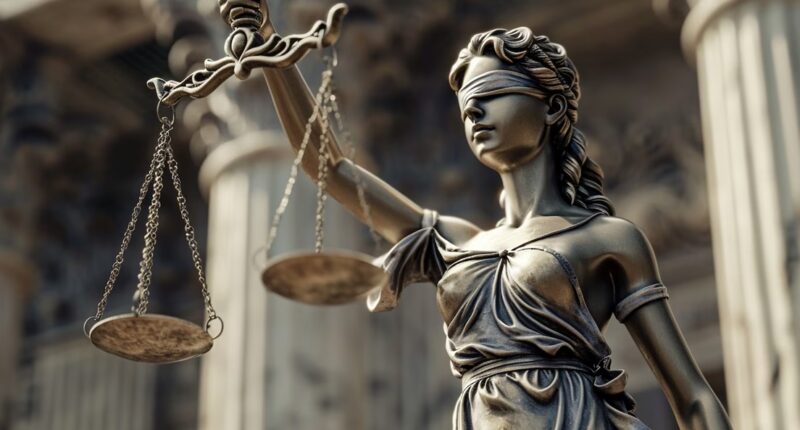Table of Contents Hide
The figure of the Lady of Justice is one of the most recognizable symbols in legal systems worldwide. She is often depicted as a woman holding a set of scales in one hand and a sword in the other, and in some versions, she is blindfolded. This iconic figure represents the principles of justice fairness, balance, equality, and truth that are fundamental to law and governance.
But who exactly is the Lady of Justice, and how did she come to represent these principles? This article delves into the history, symbolism, and cultural significance of the Lady of Justice, exploring how she has evolved from ancient mythology to modern courthouses around the world.
The Origins of the Lady of Justice
The Lady of Justice is not a singular figure, but a composite of various mythological and philosophical ideas about justice from different cultures and time periods. Her modern representation can be traced back to a mix of Roman, Greek, and Egyptian mythology, all of which contributed to the current imagery of justice.
1. The Egyptian Goddess Ma’at
The earliest roots of the Lady of Justice may be found in ancient Egypt, where Ma’at, the goddess of truth, balance, and justice, played a central role in the culture’s understanding of morality and law. Ma’at was believed to regulate the stars, seasons, and actions of both mortals and gods. She was also involved in the Egyptian afterlife, where the deceased’s heart would be weighed against her feather to determine whether they would enter the afterlife or be devoured by the demon Ammit.
Ma’at’s role as a divine enforcer of cosmic order (also known as “maat”) ensured that justice and truth were always aligned. Her imagery, including the scales used to weigh the souls of the dead, strongly influenced later depictions of justice, particularly the scales held by the Lady of Justice today.
2. The Greek Goddess Themis
The Greek goddess Themis is another important precursor to the Lady of Justice. Themis was a Titaness and the personification of divine law and order. In Greek mythology, she was often portrayed as an advisor to Zeus, guiding the king of the gods with wisdom and foresight. Themis is often depicted with scales in one hand, symbolizing the weighing of evidence, and a sword in the other, representing swift and impartial punishment.
Themis is notable for her embodiment of natural law—an unwritten but fundamental moral code that governs human behavior. Unlike human laws, which could be flawed or unjust, Themis stood for eternal truths and universal justice. Her role as a counselor of justice continues to resonate in the symbolism of the modern Lady of Justice.
3. The Roman Goddess Justitia
The Roman adaptation of the Greek Themis was Justitia, the goddess of justice, who has the most direct connection to the modern Lady of Justice. Justitia was one of the virtues, alongside others like Prudence and Temperance, and she was associated with fairness, legal equity, and moral righteousness.
In Roman art, Justitia was depicted with similar attributes to the Greek Themis, including scales and a sword. What distinguishes Justitia, however, is the occasional blindfold. The blindfold is a relatively modern addition to the depiction of justice, symbolizing impartiality and the idea that justice should be applied without regard to wealth, power, or status. Roman depictions of Justitia have greatly influenced the image of Lady Justice that we see in legal settings today.
Symbolism of the Lady of Justice
The various attributes of the Lady of Justice—her scales, sword, and blindfold—are rich in meaning, each representing different facets of the judicial system and the moral ideals it upholds.
1. The Scales
The scales held by the Lady of Justice are perhaps her most recognizable attribute. They represent the weighing of evidence and facts in a case to achieve a balanced and fair judgment. The scales symbolize the process of carefully considering all sides of an argument, ensuring that decisions are made based on objective evidence rather than emotions, prejudice, or external pressures.
In courts of law, these scales serve as a reminder that justice must be blind, impartial, and balanced. They also emphasize the importance of fairness in the legal process, where both the defense and the prosecution are given equal consideration before a decision is made.
2. The Sword
The sword in the Lady of Justice’s hand symbolizes the authority and enforcement of justice. It represents the power of the law and the state’s ability to punish wrongdoers. The sword is usually double-edged, signifying that justice can rule either in favor of or against an individual, depending on the merits of the case.
Furthermore, the sword is a symbol of swift justice, implying that justice should be delivered without unnecessary delay. It emphasizes that the law is not just about weighing evidence but also about ensuring that those who violate it face consequences, thereby maintaining order and deterring future wrongdoing.
3. The Blindfold
The blindfold, a more modern addition to the depiction of Lady Justice, stands for impartiality. By being blindfolded, the Lady of Justice cannot see the individuals before her—whether they are rich or poor, powerful or powerless, guilty or innocent—and thus her decisions are based solely on the law and the facts presented. The blindfold symbolizes objectivity and the ideal that justice should be dispensed without bias or favoritism.
However, in some artistic representations, the Lady of Justice is not blindfolded. This difference reflects varying interpretations of justice. Some believe that justice should not be blind and that judges must see the circumstances surrounding a case to deliver the fairest verdict. Nonetheless, the blindfold has become a powerful symbol of neutrality in modern legal systems.
4. The Robes
The robes worn by the Lady of Justice are often flowing and classical, representing the dignity and honor of the legal profession. They serve as a reminder of the moral gravity of the judicial process. The robes also connect the modern image of justice to its ancient roots, evoking the timeless pursuit of fairness and righteousness.
The Lady of Justice in Modern Legal Systems
The image of the Lady of Justice is widely used in courts, government buildings, and legal institutions worldwide. Her symbolism transcends borders and cultures, standing for the universal ideals of fairness, equality, and the rule of law. As a figure who embodies the pursuit of justice, she is often used to remind legal professionals and the public of the principles that should guide the judicial process.
In many courtrooms, statues of the Lady of Justice stand tall, reinforcing the solemnity of legal proceedings and the importance of upholding justice for all. Her scales, sword, and blindfold serve as constant reminders that justice should be pursued without prejudice and that laws should be applied equally to everyone.
Controversies and Modern Interpretations
While the Lady of Justice is an enduring symbol of fairness and morality, her depiction is not without controversy. Critics argue that justice is not always blind and that biases based on race, class, gender, and wealth still permeate legal systems worldwide. For example, many marginalized communities argue that the scales of justice are often tipped in favor of the powerful and the privileged, a reality that contradicts the ideal symbolized by the Lady of Justice.
This tension has led to re-examinations of what the Lady of Justice represents in modern contexts. Some legal scholars and activists suggest that the blindfold should be seen not just as a symbol of impartiality, but also as a challenge to legal systems to live up to the ideal of equality under the law.
Conclusion: The Lady of Justice’s Enduring Legacy
The Lady of Justice has endured through centuries as a powerful symbol of fairness, equity, and the rule of law. Rooted in ancient mythologies of Egypt, Greece, and Rome, her attributes of scales, sword, and blindfold continue to inspire modern legal systems to uphold the highest standards of justice.
However, her presence also reminds us that the pursuit of justice is ongoing and that legal systems must constantly strive to be fair and impartial, ensuring that justice truly is blind and available to all, regardless of their background or circumstances.
In a world where debates around fairness, equality, and the application of the law continue, the Lady of Justice remains a compelling and relevant figure, symbolizing both the ideals we strive for and the challenges we face in achieving true justice for all.










